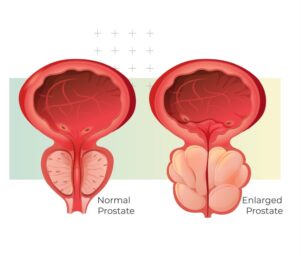Benign prostatic enlargement (BPE) affects about half of men over 50, yet many dismiss early symptoms. Consultant urologist Dr Edwin J Aslim warns that timely detection can prevent serious complications, improve quality of life, and help men avoid invasive treatments later.
WORDS LIM TECK CHOON
 FEATURED EXPERT FEATURED EXPERTDR EDWIN J ASLIM Consultant Urologist Department of Urology Singapore General Hospital |
Benign prostatic enlargement (BPE) describes the non-cancerous enlargement of the prostate.

- BPE is surprisingly common among Malaysian men, especially those over 50.
- “Local studies show Malaysian men are equally affected as men in the West,” explains consultant urologist Dr Edwin J Aslim.
- He adds that BPE affects men from all races equally, and about 50% of men above 50 experience symptoms.
SPOTTING THE BPE WARNING SIGNS
BPE doesn’t always make itself obvious, but certain urinary changes shouldn’t be ignored. Dr Aslim lists common early signs:
- A hesitant, interrupted, weak urine stream, often with dribbling of urine.
- Urgency with or without urine leakage.
- More frequent urination, especially at night.
Symptom severity doesn’t always match gland size.
- Some men with greatly enlarged prostates may barely notice symptoms.
- Others with smaller enlargements but more severe shape distortions may feel significantly more bothered by their symptoms.
Seek Immediate Medical Attention If:
- There is blood in the urine
- One experiences unusual and unexplained weight loss
- There is unexplained bodily pain
Medical tests will be needed to rule out the presence of cancer.
Early detection is key, as untreated BPE can lead to:
- Urinary retention
- Bladder stones
- Infections
- Permanent kidney damage
HOW BPE IS DIAGNOSED
If you notice symptoms, a urologist can perform several tests.
Dr Aslin reveals that common BPE diagnostic tools include:
- Digital rectal examination (DRE). The doctor inserts a gloved finger into the rectum and feels the prostate next to the rectum. This gives him a general idea of the size and condition of the gland.
- Urine flow study. A person urinates into a special device that measures how quickly the urine is flowing. A reduced flow often suggests BPE.
- Cystoscopy. A cytoscope — a small tube with a camera system — is passed through the opening of the urethra of the penis into the bladder. It helps the doctor visually assess the inner structures of the urethra, prostate, and the bladder to identify the location and degree of the obstruction.
| Is digital rectal exam embarrassing and painful? Find out why it’s not that unpleasant from consultant urologist Dr Yeoh Wei Sien! |
TREATMENT OPTIONS FOR BPE
Treatment depends on symptom severity and patient needs.
Lifestyle Changes
“For mild cases, conservative management like lifestyle changes may be enough,” says Dr Aslim.
- Exercise can boost the overall physical health and fitness of the body, and can improve the symptoms of BPE.
- A balanced diet rich in fibre, vitamins and minerals may help slow the progression of BPE.
- For men with mild symptoms, cutting back on caffeine can reduce the sudden, strong need to pee.
Medications
Medications are available to relax prostate muscles and improve urine flow or to slow prostate enlargement.
“They can be offered for men with mild symptoms without significant blockage of the bladder,” Dr Aslin says.
“Compared to surgery, medications have fewer treatment risks, but they are also generally not as effective as surgery,” he adds.
Surgery
Surgery is considered when symptoms are severe or when medications fail to give the desired results. Surgical options include:
Transurethral resection of the prostate (TURP)
- Dr Aslim reveals that this is the most common surgical technique for BPE.
- With the patient under anaesthesia, the surgeon will insert a resectoscope is inserted through the penis.
- The resectoscope is a thin, tube-like instrument with a light, a lens, and a tool that uses an electric current at the other end.
- The surgeon uses the resectoscope with an electrical cutting wire loop to resect and remove the obstructing prostate tissue one piece at a time.
- The pieces of tissue are then flushed out at the end of the operation.
Laser enucleation
- Dr Aslim explains that, in this procedure, a laser resectoscope is inserted into the patient’s urethra.
- Laser energy is then used to cut the prostate tissue while at the same time seal the blood vessels to reduce bleeding.
- As with TURP, laser surgery requires anaesthesia and a hospital stay.
- This technique is often selected for men with larger glands or those on blood thinning medicines, as the laser energy is superior in bleeding control.
- This allows a faster recovery and shorter hospital stay compared to TURP in this group of patients.
Minimally invasive surgical treatments (MIST)
- These options are generally non-cutting, so the main advantage is the preservation of sexual functions (erection and ejaculation).
- Other advantages are improved recovery experience and a fewer side effects.
- Examples of MIST include:
- Prostatic urethra lift (UroLift)
- Convective water vapour thermal therapy (Rezum)
- Temporary nitinol device (I-TIND)
- The main disadvantage of MIST is that the positive results may not last as long as those of more invasive surgeries.
Dr Aslim tells us: “Treatment must be tailored based on the patient’s needs. For example, a younger man may prioritize preserving his sexual function, while an older man may want long-term relief from urinary retention.”
BREAKING THE SILENCE AROUND BPE
Many men hesitate to discuss urinary or sex-related issues, but early intervention is crucial.
“These topics can be sensitive, but seeing a urologist helps focus on the issues that require medical attention,” Dr Aslim says.
Proactive attention to prostate health can prevent serious complications, improve day-to-day comfort, and, most importantly, protect your kidneys and bladder in the long run.
| This article is part of our series on tips and advice on men’s health, sex life, and fertility. |













